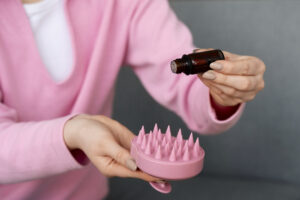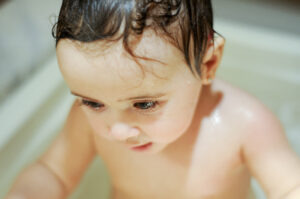How to treat baby eczema naturally?
Infant seborrheic dermatitis, also called cradle cap, is a very common but benign condition that occurs in most newborns and babies. It is characterized by yellowish patches and scaly scales on the scalp, although it can also appear on the eyebrows or behind the ears. A cradle cap usually clears up on its own, but there are some things you can do to prevent or minimize its occurrence. This guide introduces easy yet practical measures to keep your baby’s scalp healthy and free from cradle caps.
Understanding Infantile Seborrheic Dermatitis

Before discussing prevention techniques, it is essential to understand what causes cradle caps. The condition is said to be due to an overproduction of oils (sebum) in the baby’s skin, initiated by lingering maternal hormones. Although not harmful or contagious, some parents may find its appearance distressing.How to treat baby eczema naturally
Remedies to Reduce Cradle Cap
1. Wash Your Baby’s Scalp Daily
The scalp must always be cleaned so the cradle cap does not develop. Washing with a mild baby shampoo a few times a week removes the buildup of excess oil, dead skin, and more.
Select a mild shampoo: Choose one that is labeled hypoallergenic and designed for babies.
Don’t overdo it: Washing too often can dry out the scalp, which could worsen the cradle cap.How to treat baby eczema naturally
2. Gentle Massage with Oils to Soften the Scalp

Massage in oils before washing to help soften the skin and loosen flakes. Popular oils include:
Coconut oil
Sweet almond oil
Olive oil
Massage a little oil into the scalp, leave it on for about 20 minutes, and then wash it off with baby shampoo How to treat baby eczema naturally
3. Gently Brush the Scalp
After shampooing, gently massage your baby’s scalp, thereby removing all the flakes and helping to keep oil from accumulating.
Soft brushes: It is best to use a baby brush with soft bristles.How to treat baby eczema naturally
Work in small circles: This will help distribute all those natural oils into the scalp evenly.
4. Scalp Moisturizer

Dryness can irritate the scalp, increasing the likelihood of a cradle cap. After shampooing, consider applying a lightweight, baby-safe moisturizer to the scalp. Ensure it’s free from strong fragrances or chemicals.How to treat baby eczema naturally
How Your Diet May Affect Your Baby’s Skin
If you’re breastfeeding, your diet could play a role in your baby’s overall skin health. Eating nutrient-rich foods can help maintain healthy skin. Focus on:
Omega-3 fatty acids: These are in fatty fish, flaxseeds, and walnuts.
Vitamin E: This can be gotten from spinach, almonds, and sunflower seeds.
Zinc-rich foods: Examples of these are beans, whole grains, and lean meats.How to treat baby eczema naturally
For babies on formula, consult your pediatrician to ensure they receive the appropriate amount of nutrition.
Environmental Adaptations for Healthy Skin
5. Do Not Overheat Your Baby

Heat and sweating can flare up the cradle cap. Dress your baby in breathable fabrics, and make sure the room temperature is pleasant.How to treat baby eczema naturally
6. Use Baby-Safe Laundry Products
Wash your baby’s clothes, hats, and bedding using fragrance-free, hypoallergenic detergents to prevent irritation on the scalp. Harsh chemicals can irritate sensitive skin more.
When to Seek Medical Attention
Though usually harmless, see a pediatrician if:How to treat baby eczema naturally
It spreads to other areas such as the face, neck, or chest.
You experience redness, swelling, or fluid seepage, which might indicate an infection.
It does not improve despite trying home care measures.
A doctor may recommend medicated shampoos or creams for serious cases.
Myths Regarding Cradle Cap
1. Cradle cap is caused by poor hygiene.

This is a fallacy. Cradle cap occurs due to natural hormonal changes and the production of oil, not because of unhygienic conditions.How to treat baby eczema naturally
2. Do Not Wash the Scalp Entirely
On the contrary, thorough washing with a mild shampoo forms the main preventive measure.
3. Any Oil Can Be Used

Not all oils are suitable for a baby’s delicate skin. Test a small area before using, and consult a pediatrician if unsure.How to treat baby eczema naturally
Natural Remedies for Preventing Cradle Cap
For parents who prefer home remedies, here are a few safe and effective options:
Aloe Vera Gel: Its soothing and moisturizing properties can prevent scalp dryness.
Baking Soda Paste: Mix baking soda and water to form a paste and apply it gently. Rinse off after a few minutes.
Chamomile Tea: Use chamomile tea as a rinse for the scalp to reduce irritation and moisten the skin.
Always patch test before applying the remedies to avoid any adverse reaction to the baby.
Family and Genetic History
Cradle cap sometimes runs in families. If you or your spouse had the same or similar conditions when you were an infant, your baby will be more prone to it. However, this cannot be completely avoided. When taken care of properly, its symptoms can be lessened.
Shaping a Scalp Care Routine
In preventing cradle caps, there is one essential thing: consistency:
Bathe and lotion the scalp regularly.
Brush gently every day.
Use baby-safe mild products.
Check the scalp for changes or buildup.
By establishing a routine, you help prevent cradle caps even develop healthy habits, and spend good bonding time with your baby.
Conclusion
Prevention of cradle caps involves regular scalp care, the use of safe products, and maintaining a healthy environment for your baby. Not being contagious, this condition is usually benign and temporary; however, taking proactive measures can reduce its occurrence and leave your baby more comfortable.
